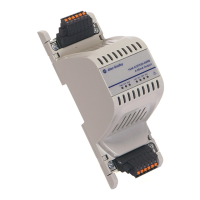Rockwell Automation Publication 1444-UM001D-EN-P - June 2018 163
Measurement Definition Chapter 4
A Guide to Setting Alarm and Trip Setpoints
The objective of thrust monitoring is to help protect the machine, not the
thrust bearing. For example, to help prevent the rotating element from coming
into contact with the stationary parts of the machine, which results in
considerable damage, lost production and repair costs.
Some wear of the thrust bearing pads is acceptable to avoid unnecessary alarms
and machine trips.
A typical thrust pad has around 0.75 mm to 1.00 mm (30...40 mils) of “white
metal” or “Babbitt’ (inspection of the thrust pads confirms it) material. Taking
the preceding steam turbine application as an example with plus 5 mils (0.127
mm) as the normal running position, we could set the Alarm setting at 6 mils
and 11 mils and the trip setting at 12mils and17mils (+0.28 mm and +0.43
mm).
These settings can help verify that the thrust pads can suffer some wear before
the machine was tripped but before any damage to the machine itself.
The same logic is applied for thrust against the inactive pads, so here we have to
consider the float to determine the alarm and trip points in the counter
direction.
In all cases, refer to the machine OEM for specific advice on the setting of
alarm and trip points.
Updating a System from Revision 1 AOP and Firmware to Revision 2
If the existing system has the initial release AOP (V053) and Firmware
(V2.1.3) and:
a. The firmware in the 1444 Module is updated to a later version such
as 2.1.7 no changes to the configuration are necessary.
b. If both the AOP and firmware revisions are updated to version 2,
then the configuration must be modified as follows. For an AWAY
configuration, the OFFSET must be changed to a Minus value and
for a TOWARD configuration the OFFSET value must be changed
to a Plus value. (The earlier version 1 AOP and Firmware required
the opposite to these settings).

